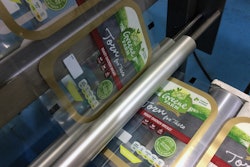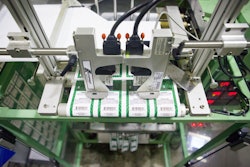
Not only does it rule out ink-jet printing on cases for the 14-digit Global Trade Item Number (GTIN) and the bar code symbol representing that number, but it also stipulates that all four sides of a corrugated case must carry trade item information.
Driving this announcement—which affects primarily dry grocery and food items, excluding fresh meat, fish, poultry, and produce--is Walmart’s claim that its store associates aren’t able to get merchandise onto a store shelf efficiently enough when master cases don’t have trade item information on all four sides or when the bar code is illegible and thus can’t be scanned. And because, claims Walmart, bar codes printed with ink-jet technology are not as consistently legible as those printed flexographically, henceforth only flexo will be accepted by Walmart where printing of GTIN on corrugated cases is concerned.
To understand why this edict has CPG companies scratching their heads, it’s important to analyze separately its two key components: A) Walmart’s dim view of ink jet and B) Walmart’s requirement for four-side-printing. Let’s start with ink jet.
Ink-jet printing is a key strategy that CPG companies rely on to keep corrugated inventories to a minimum. Suppose, for example, that ABC Yogurt Company makes the same 6-oz yogurt product in grape, cherry, pineapple, peach, and strawberry varieties. The identical case can be used for all five varieties. The firm’s corrugated supplier uses a flexographic press to print the ABC Yogurt Company logo on all of the cases, and because the artwork is the same for all the cases it means large orders, long runs, and fewer printing plate costs. All of this maximizes efficiency and reduces overall cost. And the flavor variations? They get ink-jet-printed on ABC Yogurt’s packaging lines along with the GTIN that is specific to each flavor variety as well as lot and date code info.
Now imagine that ink-jet printing is no longer in compliance and only flexographic printing is allowed. It means that ABC Yogurt will no longer be able to use ink-jet printing to practice late-stage customization on its packaging lines and will have to have its corrugated supplier print five different cases where it now prints just one. That will shorten case printing runs, add to the number of printing plates required, increase inventory complexity five-fold, and drive up costs. It will also greatly increase the likelihood of packaging obsolescence, which will result in more corrugated cases going to the landfill—so much for sustainable packaging.
A number of observers I spoke to want to know where Walmart gets off saying that ink-jet-printed bar codes are unreliable when both ANSI and UCC councils thoroughly analyzed their use for an extended period of time and pronounced them reliable. The same observers are quick to point out that if indeed ink-jet-printed bar codes are not as consistently legible as Walmart wants them to be, there’s a much less draconian solution available: Require CPG companies to scan 100% of the ink-jet bar codes they print on their packaging lines and use readily available controls technology to immediately reject any case that is not up to par.
As for the four-side-print issue, it means CPG companies will have to reconfigure their lines with bump-and-turn stations so that lot and date code information that they currently print on just one or two sides can now be printed on all four sides.
All indications are that Walmart wants to implement this mandate as quickly as possible. If you’re reading this and have an opinion to share on this mandate, please send it my way—now.
Also, watch for further coverage of this issue in our May issue. We’ll be reaching out to Walmart in the hope of getting some kind of explanation or justification.
























